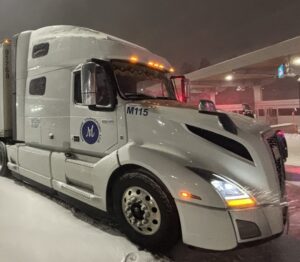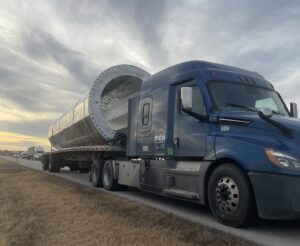KINGSHILL, U.S. Virgin Islands — President Joe Biden on Thursday, Dec. 29, signed a $1.7 trillion spending bill that will keep the federal government operating through the end of the federal budget year in September 2023.
The bill also includes multiple items that affect the nation’s transportation network and the trucking industry.
Biden had until late Friday, Dec. 30, to sign the bill to avoid a partial government shutdown.
In the bill, Congress has requested that the National Highway Traffic Safety Administration (NHTSA) begin rulemaking to improve the visibility of commercial trucks weighing more than 10,000 pounds by requiring them to sport special reflective tape.
The Federal Motor Carrier Safety Administration and National Highway Traffic and Safety Administration (NHTSA) also received significant funding and directives.
The Democratic-controlled House passed the bill 225-201, mostly along party lines, just before Christmas. The House vote came a day after the Senate, also led by Democrats, voted 68-29 to pass the bill with significantly more Republican support.
Biden had said passage was proof that Republicans and Democrats can work together.
Rep. Kevin McCarthy, the House Republican leader who hopes to become speaker when a new session Congress opens on Jan. 3, argued during floor debate that the bill spends too much and does too little to curb illegal immigration and the flow of fentanyl into the U.S. from Mexico.
“This is a monstrosity that is one of the most shameful acts I’ve ever seen in this body,” McCarthy said of the legislation.
McCarthy is appealing for support from staunch conservatives in the GOP caucus, who have largely blasted the bill for its size and scope. Republicans will have a narrow House majority come Jan. 3 and several conservative members have vowed not to vote for McCarthy to become speaker.
TRANSPORTATION FUNDS
The bill will allocate $106.3 billion to the U.S. Department of Transportation (USDOT) and its agencies, which is more than $3 billion than the agency received a year ago and $1.9 billion more than the White House requested.
The money will fund national infrastructure improvements via grants to states, municipalities, Tribal authorities and metropolitan planning organizations.
The bill also includes $800 million for national infrastructure investment grants.
Specifically, the bill allocates:
- A total of $62.9 billion to the FHWA — $3.4 billion of which is earmarked for highway infrastructure programs and projects.
- More than $873 million to the FMCSA, which includes $5 million for a commercial motor vehicle driver’s license program, along with $15 million for autonomous vehicle research in rural areas.
- A total of $5 million for commercial motor vehicle enforcement training and support.
- A total of $1.2 million for a commercial motor vehicle operators grant program.
The NHTSA will receive $1.2 billion — $9 million of which Congress has directed the agency to spend on testing automated vehicles.
Along with its funding, the FHWA, like the NHTSA, received a set of directives from Congress.
They are:
- Research and develop infrastructure with new and proven technologies.
- Begin pilot programs for wildlife crossings along highways.
- Work with departments of transportation across the nation, along with local governments, to begin projects in the inter-mountain West, including interstates 10, 11 and 17. The work is also to include expanding U.S. 95, as well as studying a new, 50-mile route in Arizona between U.S. 60 and I-10.
- Completing the controlled-access Sonoran corridor in Arizona from interstates 19 and 10.
Passage of the bill was achieved hours before financing for federal agencies was set to expire. Lawmakers had approved two short-term spending measures to keep the government operating, and a third, funding the government through Dec. 30, passed on Friday, Dec. 23.
Biden signed it to ensure services would continue until Congress sent him the full-year measure, called an omnibus bill.
The massive bill, which topped out at more than 4,000 pages, wraps together 12 appropriations bills, aid to Ukraine and disaster relief for communities recovering from natural disasters. It also contains scores of policy changes that lawmakers worked to include in the final major bill considered by that session of Congress.
Lawmakers provided roughly $45 billion for Ukraine and NATO allies, more than even Biden had requested, an acknowledgment that future rounds of funding are not guaranteed when Republicans take control of the House next week following the party’s gains in the midterm elections.
Though support for Ukraine aid has largely been bipartisan, some House Republicans have opposed the spending and argued that the money would be better spent on priorities in the United States.
McCarthy has warned that Republicans will not write a “blank check” for Ukraine in the future.
The bill also includes about $40 billion in emergency spending, mostly to help communities across the U.S. as they recover from drought, hurricanes and other natural disasters.
The White House said it received the bill from Congress on the afternoon of Wednesday, Dec. 28. It was delivered to Biden for his signature by White House staff on a regularly scheduled commercial flight.
Biden signed the bill in the U.S. Virgin Islands, where he is spending time with his wife, Jill, and other family members on the island of St. Croix. The Bidens are staying at the home of friends Bill and Connie Neville, the White House said. Bill Neville owns US Viking, maker of ENPS, a news production software system that is sold by The Associated Press.
Also in the bill are scores of policy changes that are largely unrelated to spending, but lawmakers worked furiously behind the scenes to get the added to the bill, which was the final piece of legislation that came out of that session of Congress. Otherwise, lawmakers sponsoring these changes would have had to start from scratch next year in a politically divided Congress in which Republicans will return to the majority in the House and Democrats will continue to control the Senate.
One of the most notable examples was a historic revision to federal election law to prevent a future president or presidential candidate from trying to overturn an election.
The bipartisan overhaul of the Electoral Count Act is a direct response to-then President Donald Trump’s efforts to persuade Republican lawmakers and then-Vice President Mike Pence to object to the certification of Biden’s victory on Jan. 6, 2021, the day of the Trump-inspired insurrection at the Capitol.
Among the spending increases Democrats emphasized: a $500 increase in the maximum size of Pell grants for low-income college students, a $100 million increase in block grants to states for substance abuse prevention and treatment programs, a 22% increase in spending on veterans’ medical care and $3.7 billion in emergency relief to farmers and ranchers hit by natural disasters.
The bill also provides roughly $15.3 billion for more than 7,200 projects that lawmakers sought for their home states and districts. Under revamped rules for community project funding, also referred to as earmarks, lawmakers must post their requests online and attest they have no financial interest in the projects. Still, many fiscal conservatives criticize the earmarking as leading to unnecessary spending.
The Trucker Staff contributed to this report.
The Associated Press is an independent global news organization dedicated to factual reporting. Founded in 1846, AP today remains the most trusted source of fast, accurate, unbiased news in all formats and the essential provider of the technology and services vital to the news business. The Trucker Media Group is subscriber of The Associated Press has been granted the license to use this content on TheTrucker.com and The Trucker newspaper in accordance with its Content License Agreement with The Associated Press.















Why don’t ALL the damn blame quit being put on truckers and start looking at the 4 wheelers around us too that cause truck accidents. It’s not always us, a good chunk of the time it’s not because something we did. They can take more regulations and shove them up their ass.
The Spending bill full of crap as usual.